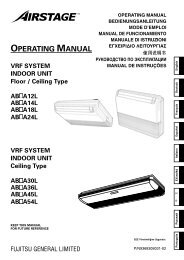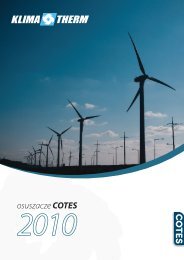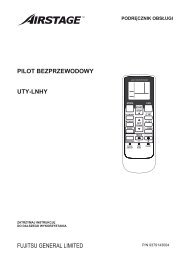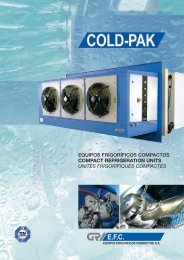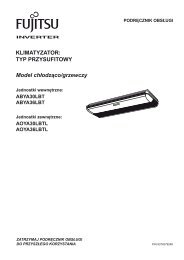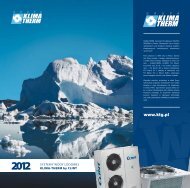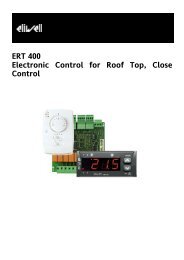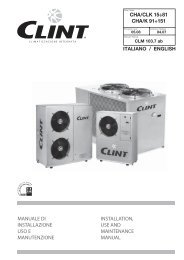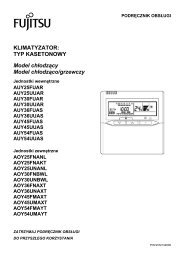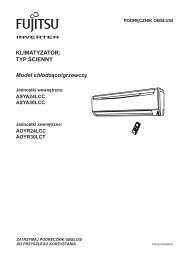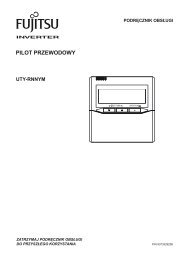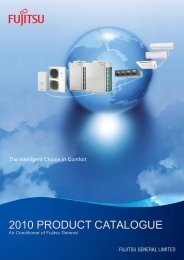marvin - Klima-Therm
marvin - Klima-Therm
marvin - Klima-Therm
Create successful ePaper yourself
Turn your PDF publications into a flip-book with our unique Google optimized e-Paper software.
Manuale installazione, uso e manutenzione • Ventilconvettori<br />
Installation, use and maintenance manual • Fan coil units<br />
<strong>marvin</strong><br />
Serie/Series<br />
Emissione/Edition<br />
Catalogo/Catalogue<br />
FVW 12÷74<br />
CLM 82<br />
Sostituisce/Supersedes<br />
04.06 05.05
G. I. Holding S.p.A. Vi ringrazia per la fiducia concessagli nell’acquisto del ventilconvettore.<br />
Il manuale deve essere letto completamente ed attentamente. Le diciture “Pericolo” o<br />
“Attenzione” riportate nelle norme d’uso devono essere oggetto di particolare attenzione; se<br />
non osservate possono essere causa di danno al ventilconvettore e/o a persone e cose.<br />
G. I. Holding S.p.A. declina ogni responsabilità per eventuali danni provocati dalla non attenta<br />
lettura del presente manuale o da un uso improprio del ventilconvettore.<br />
Per eventuali anomalie non indicate su questo manuale si prega contattare tempestivamente<br />
il servizio assistenza tecnica.<br />
Attenzione!<br />
Conservare i manuali in luogo asciutto per evitare il deterioramento, per eventuali<br />
consultazioni future.<br />
Prestazioni / Performances<br />
(1) Alla distanza di 1 m e tempo di riverbero 0,5 s.<br />
Pressione massima di esercizio 1000 kPa.<br />
Temperatura massima acqua in ingresso 90 °C.<br />
L’acqua può essere addizionata con glicole etilenico inibito.<br />
1.3 Componenti<br />
1 Vano pannelli di comando<br />
Vano predisposto per ospitare i pannelli di comando di cui può essere<br />
dotato l’apparecchio.<br />
C<br />
A<br />
2 Ventilatore<br />
Di tipo centrifugo direttamente accoppiato a un motore elettrico monofase<br />
a 6 velocità, delle quali 3 collegate nella B configurazione standard.<br />
G. I. Holding S.p.A. thanks you for your choice in the purchase of this fan coil unit.<br />
This manual must be read completely and carefully. The messages “Danger” and “Warning” in<br />
the usage insructions must be given special attention; if they are not observed there may be<br />
damage to the fan coil unit and/or to persons and things.<br />
G. I. Holding S.p.A. declines any responsibility for any damage caused by inattentive reading<br />
of this manual or by improper use of the fan coil unit.<br />
For any abnormalities not covered by this manual, please promptly contact technical customer<br />
service.<br />
Attention!<br />
Keep manuals in a dry place to avoid their deterioration, for future reference.<br />
Modello 2R - 3R - 4R 12 22 32 42 52 62 72<br />
13 23 33 43 53 63 73<br />
14 24 34 44 54 64 74<br />
Portata aria Air flow max m 3 /h 240 340 430 540 690 910 1180<br />
med m 3 /h 190 260 340 420 530 730 810<br />
min m 3 /h 140 170 250 280 400 510 590<br />
Pressione sonora (1) Sound pressure level (1) max dB(A) 41 44 40 44 46 48 52<br />
med dB(A 34 38 34 37 39 43 42<br />
min dB(A 26 26 25 27 33 34 34<br />
Alimentazione elettrica Supply voltage V/Ph/Hz <br />
Potenza assorbita Absorbed power max kW 0,02 0,04 0,05 0,07 0,08 0,16 0,20<br />
Attacchi idraulici Water connections “G ½” ½” ½” ½” ½” ½” ½”<br />
Peso Weight kg 16 19 24 28 33 43 54<br />
(1) At a distance of 1 m and with reverberation time of 0.5 s.<br />
Maximum operating temperature 1000 kPa.<br />
Maximum inlet water temperature 90 °C.<br />
Inhibited ethylene glycol can be added to the water.<br />
Dimensioni, caratteristiche tecniche e componenti / Dimensions, technical characteristics and components<br />
1.1 Dimensioni / Dimensions<br />
Telaio interno / Internal frame<br />
B<br />
D<br />
4<br />
1<br />
2<br />
A<br />
C<br />
E<br />
1.2 Caratteristiche tecniche<br />
Il ventilconvettore è una unità terminale per il trattamento dell’aria degli<br />
ambienti nel periodo estivo e invernale. Le versioni sono:<br />
VP Unità verticale con mantello (ripresa inferiore e mandata verticale)<br />
VH Unità verticale con mantello (ripresa frontale e mandata verticale)<br />
VE Unità orizzontale con mantello (ripresa posteriore e mandata orizzontale)<br />
VO Unità orizzontale con mantello (ripresa inferiore e mandata orizzontale)<br />
C<br />
3<br />
8<br />
A<br />
2<br />
9<br />
B<br />
6<br />
5<br />
7<br />
MOD. 12 22 32 42 52 62 72<br />
13 23 33 43 53 63 73<br />
14 24 34 44 54 64 74<br />
A mm 440 560 760 960 1160 1135 1410<br />
B mm 475 475 475 475 475 545 545<br />
C mm 185 185 185 185 185 250 250<br />
D mm 416 536 736 936 1136 1111 1386<br />
E mm 310 310 310 310 310 380 380<br />
F mm 50 50 50 50 50 45 45<br />
G mm 85 85 85 85 85 165 165<br />
H mm 50 50 50 50 50 43 43<br />
I mm 267 267 267 267 267 265 265<br />
L mm 148 148 148 148 148 220 220<br />
M mm 60 60 60 60 60 60 60<br />
N mm 70 70 70 70 70 70 70<br />
Mod. 12 22 32 42 52 62 72<br />
13 23 33 43 53 63 73<br />
14 24 34 44 54 64 74<br />
A mm 690 820 1080 1210 1470 1470 1730<br />
B mm 500 500 500 500 500 570 570<br />
C mm 210 210 210 210 210 275 275<br />
D mm 90 90 90 90 90 90 90<br />
E mm 30 30 30 30 30 30 30<br />
1.2 Technical characteristics<br />
The fan coil unit is a terminal unit for the treatment of room air in the<br />
summer and winter seasons. The versions are:<br />
VP Vertical unit with cabinet (lower suction and vertical delivery)<br />
VH Vertical unit with cabinet (front suction and vertical delivery)<br />
VE Horizontal unit with cabinet (rear suction and horizontal delivery)<br />
VO Horizontal unit with cabinet (lower suction and horizontal delivery)<br />
1.3 Components<br />
1 Control panel compartment<br />
Compartment provided to house the control panels with which the<br />
appliance may be equipped.<br />
2 Fan<br />
Centrifugal type directly coupled to a 6-speed single-phase electric motor,<br />
with 3 speeds connected in the standard configuration.
3 Mobiletto di copertura<br />
È realizzato in lamiera d’acciaio preverniciata ad alta resistenza alla<br />
corrosione ed alla ruggine.<br />
4 Filtro aria<br />
Filtro lavabile a secco, in materiale acrilico, inserito in un robusto telaio<br />
in lamiera zincata.<br />
5 Telaio interno<br />
Costruito con lamiera zincata di elevato spessore con fori pretranciati<br />
per le varie configurazioni.<br />
6 Scarico condensa<br />
Permette lo scarico della condensa anche in condizioni particolari data<br />
la particolare capienza della vaschetta e il notevole diametro del tubo<br />
di scarico.<br />
7 Collegamenti idraulici<br />
I collegamenti idraulici si trovano normalmente nel fianco dx del ventilconvettore,<br />
a sx se viene ruotata la batteria di scambio termico, e sono<br />
da 1/2” G per qualsiasi modello.<br />
8 Batteria di scambio termico<br />
Costituita da una batteria alettata in tubi di rame ed alette corrugate<br />
in alluminio.<br />
9 Valvole sfiato aria<br />
Si trovano sugli attacchi idraulici della batteria e permettono lo sfiato<br />
dell’aria dalla batteria stessa.<br />
Installazione, collegamenti elettrici e avviamento / Installation, electrical connections and start-up<br />
2.1 Installazione del ventilconvettore<br />
Il ventilconvettore deve essere installato perfettamente orizzontale e<br />
in posizione che consenta di effettuare facilmente la manutenzione<br />
ordinaria (pulizia filtri) nonchè quella straordinaria.<br />
Per installare il ventilconvettore procedere nel seguente modo:<br />
• Togliere la copertura allentando le viti di fissaggio (Fig. A).<br />
• Se sono previsti i piedini, essi devono essere montati come da istruzioni<br />
in allegato agli stessi.<br />
• Fissare il gruppo ventilante alla parete o al soffito tramite viti a tassello<br />
(Fig. B verticale, Fig. C orizzontale).<br />
• Si consiglia di collegare l’entrata dell’acqua al raccordo inferiore.<br />
Collegare i tubi per l’alimentazione della batteria ed effettuare il collegamento<br />
dello scarico condensa.<br />
• I tubi di alimentazione idraulica devono essere isolati adeguatamente<br />
per evitare fastidiosi gocciolamenti in funzionamento di raffreddamento.<br />
• Per la raccolta dell’acqua che si forma sugli attacchi idraulici va utilizzata<br />
l’apposita vaschetta raccogli condensa (opzionale).<br />
• Lo scarico della condensa deve essere adeguatamente dimensionato<br />
e le tubazioni devono mantenere per tutta la loro lunghezza<br />
una pendenza che consenta un corretto deflusso della condensa.<br />
• Se lo scarico condensa dovesse confluire nella rete fognaria è<br />
necessario realizzare un sifone che impedisca la risalita verso l’ambiente<br />
di cattivi odori (Fig. E).<br />
• Riposizionare la copertura riavvitando le viti di fissaggio.<br />
Fig. A Fig. B<br />
Attenzione!<br />
Durante il collegamento dei tubi tenere con una chiave l’esagono<br />
di raccordo della batteria in modo da non provocare danni alla<br />
stessa (Fig. D).<br />
Nota<br />
È consigliata l’installazione del ventilconvettore ad una altezza inferiore<br />
ai 3 metri.<br />
Fig. C<br />
Fig. D<br />
3 Enclosure<br />
This is realized in pre-painted, rust and corrosion resistant sheet<br />
metal.<br />
4 Air filter<br />
Washable dry air filter in acrylic material, placed in a sturdy galvanized<br />
sheet metal frame.<br />
5 Internal frame<br />
Built in thick galvanized sheet metal with pre-punched holes for the<br />
various configurations.<br />
6<br />
Condensation discharge<br />
This makes it possible to discharge the condensation even in special<br />
conditions, due to the particular capacity of the tray and substantial<br />
diameter of the discharge pipe.<br />
7 Water connections<br />
The water connections are normally found on the rh side of the fan coil<br />
unit, on the lh side if the heat excange coil is field rotated, and they<br />
measure 1/2” G for all models.<br />
8 Heat exchange coil<br />
Copper pipes and carved aluminium finns.<br />
9 Air bleed valves<br />
These are found on the water connections of the coil and make it possible<br />
to bleed air from the coil.<br />
2.1 Installation of the fan coil unit<br />
The fan coil unit must be installed in a perfectly horizontal position and<br />
in a position that allows easy access for both routine maintenance (filter<br />
cleaning) as well as special maintenance.<br />
To install the fan coil unit proceed in the following manner:<br />
• Remove the enclosure by loosening the fastening screws (Fig. A).<br />
• If feet are included they must be mounted in accordance with the<br />
instructions provided with them.<br />
• Fasten the fan group to the wall or to the ceiling with the expansion<br />
screws (Fig. B vertical, Fig. C horizontal).<br />
• It is advisable to connect the water inlet to the lower coupling.<br />
Connect the pipes for the supply of the coil and connect the condensation<br />
discharge.<br />
• The water supply pipes must be adequately insulated to avoid bothersome<br />
dripping during cooling operation.<br />
• To collect the water that forms on the water connections, a special<br />
condensation collection tub is used (optional).<br />
• The discharge of the condensation must be properly sized, and the<br />
pipes must include over their entire length an inclination that allows for<br />
proper drainage of condensation.<br />
• If the condensation drain flows into the sewer system, it is necessary to<br />
realize a trap that prevents bad odors form entering the room (Fig. E).<br />
• Fix the enclosure by the fastening screws.<br />
Fig. E<br />
Attention!<br />
During connection of the pipes, always hold the coil coupling with<br />
a wrench to avoid damaging it. (Fig. D).<br />
Note<br />
We suggest installing the fan coil unit at a height not greater than 3<br />
meters.
2.2 Rotazione della batteria<br />
Se per esigenze di installazione fosse necessario ruotare la batteria,<br />
procedere nel seguente modo:<br />
• Togliere il mantello di copertura del ventilconvettore (Fig. A).<br />
• Togliere il pannello di tamponamento 1 posto davanti alla batteria<br />
allentando le relative viti.<br />
• Sfilare la batteria 2 dall’unità ventilante dopo aver agito sui punti di<br />
fissaggio (Fig. B).<br />
• Togliere i pretranciati 3 dal fianco sx (Fig. C).<br />
• Inserire la batteria dopo averla ruotata ed infine fissarla.<br />
• Chiudere i fori degli attacchi idraulici rimasti inutilizzati sul fianco dx<br />
con della gomma adesiva 4 .<br />
• Spostare il supporto comandi e il relativo cablaggio sul fianco dx del<br />
ventilconvettore (Fig. D).<br />
• Spostare il collegamento di messa a terra 5 sul fianco dx.<br />
• Spostare la targhetta di tamponamento da sotto lo sportellino di dx<br />
a quello di sx.<br />
• Ad operazioni ultimate rimontare il mantello di copertura.<br />
Fig. A Fig. B Fig. C<br />
2.3 Collegamenti elettrici<br />
Prima di effettuare qualsiasi operazione sulla parte<br />
elettrica del ventilconvettore togliere l’alimentazione<br />
spegnendo l’interuttore generale. Ricordarsi<br />
sempre di collegare il filo di terra.<br />
Il collegamento a terra é obbligatorio per legge.<br />
L’installatore deve provvedere alla sua realizzazione<br />
utilizzando l’apposito morsetto contrassegnato<br />
dall’indicazione internazionale di messa a terra.<br />
I collegamenti elettrici devono essere effettuati<br />
come da Fig. E e Fig. F.<br />
2.4 Avviamento<br />
Sfiatare l’impianto dopo averlo riempito.<br />
Inoltre sfiatare il ventilconvettore per mezzo<br />
delle apposite valvoline e controllare il buon funzionamento<br />
del ventilconvettore.<br />
Attenzione!<br />
Il primo avviamento del ventilconvettore deve<br />
essere effettuato alla massima velocità,<br />
lasciando girare il ventilatore per circa 4/5<br />
ore. Ripetere l’operazione dopo una lunga<br />
inattività.<br />
2.5 Orientamento delle alette delle griglie<br />
• Sbloccare la griglia all’estrema dx estraendo i piolini<br />
1 (Fig. G);<br />
• Spostare tutte le griglie verso dx 2 e sganciarle<br />
dalla sede;<br />
• Orientarle nella posizione desiderata 3 ;<br />
• Inserirle nella sede e farle scorrere verso sx 4 ;<br />
• Bloccare l’ultima griglia di dx sfondando il pretranciato<br />
in corrispondenza del foro presente nel<br />
mantello o facendo corrispondere l’interspazio fra<br />
le ultime due alette con il foro presente nel mantello<br />
e reinserire i piolini 5 .<br />
4<br />
2<br />
Al comando a bordo macchina (versioni verticali)<br />
Built-in to control (vertical versions)<br />
Fig. E<br />
Fig. F<br />
Connettore<br />
Connector<br />
Al comando remoto (versioni orizzontali)<br />
Remote control (horizontal versions)<br />
Fig. G<br />
1<br />
5<br />
2.2 Coil rotation<br />
If installation requirements make it necessary to rotate the coil, proceed<br />
in the following manner:<br />
• Remov the cabinet from the fan coil unit (Fig. A).<br />
• Remove protection panel 1 located in front of the coil by loosening<br />
the relative screws.<br />
• Slide coil 2 out from the fan unit after acting on the fastening points<br />
(Fig. B).<br />
• Remove the pre-punched pieces 3 from the lf side (Fig. C).<br />
• Insert the coil after rotating it and then fasten it.<br />
• Close the holes of the water connections which are unused on the rh<br />
side with the included adhesive rubber 4 .<br />
• Move the control support with its wiring to the rh side of the fan coil<br />
unit (Fig. D).<br />
• Move earth connection 5 to the rh side.<br />
• Remove the closure template below the right door and place it below<br />
the left one.<br />
• When the operation is concluded re-install the cabinet.<br />
Connettore / Connector<br />
Fig. D<br />
2.3 Electrical connections<br />
Before carrying out any operations on the electrical<br />
part of the fan coil unit, disconnect the electrical<br />
mains power supply by turning off the main<br />
switch. Always remember to connect the earth<br />
wire. The earth connection is required by law.<br />
The installer must provide for its realization by using<br />
the appropriate terminal which is marked with the<br />
international symbol for earth connections.<br />
The electrical connections must be made as<br />
shown in the picture E and picture F.<br />
2.4 Start-up<br />
Bleed the system after having filled it.<br />
Also bleed the fan coil unit by means of the<br />
appropriate valves and check fan coil unit for<br />
proper operation.<br />
Attention!<br />
The first start-up of the fan coil unit must be<br />
made at maximum speed, letting the fan run<br />
for 4-5 hours. Repeat this operation after a<br />
long shutdown period.<br />
2.5 Grilles orienting<br />
• Free the extreme right grille lifting the pins 1<br />
(Fig. G);<br />
• Shift grilles to the right 2 and remove them;<br />
• Turn grilles as desired 3 ;<br />
• Insert grilles and shift them to the left 4 ;<br />
• Block the last grille on the right punching the<br />
precut hole of the cabinet or putting in correspondence<br />
the space between the last two<br />
finns with the hole and reinsert the pins 5 .<br />
3<br />
270°<br />
180°<br />
0°<br />
90°
Funzionamento e controllo / Operation and control<br />
3.1 Controllo velocità ventilatore a bordo<br />
macchina o a distanza (opzionale)<br />
È dotato di un selettore a tre posizioni per la selezione<br />
della velocità del ventilatore e di un altro<br />
selettore per l’accensione o lo spegnimento<br />
dell’unità.<br />
Per accendere il ventilconvettore agire su<br />
quest’ultimo selettore e selezionare il modo di<br />
funzionamento<br />
Raffreddamento<br />
Riscaldamento<br />
(viene attivato l’eventuale termostato di minima).<br />
Selezionare la velocità del ventilatore.<br />
massima media minima<br />
Alla massima velocità l’azione di riscaldamento<br />
o raffreddamento è maggiore; la regolazione<br />
della temperatura sarà in questo caso data da<br />
un termostato ambiente esterno all’unità.<br />
In riscaldamento, se presente il termostato di<br />
minima (opzionale), la ventilazione si avvia solo<br />
se la sonda rileva la tempertura prefissata.<br />
3.2 Pannello di controllo a bordo macchina o<br />
a distanza (opzionale)<br />
Pannello di controllo automatico a bordo<br />
macchina o a distanza (opzionale)<br />
Dispongono di un termostato che permette di<br />
regolare la temperatura dell’ambiente direttamente<br />
dal gruppo comando dell’unità. Per accendere<br />
il ventilconvettore agire sul selettore e<br />
selezionare il modo di funzionamento.<br />
Raffreddamento<br />
Riscaldamento<br />
Automatico auto (1)<br />
(1) La funzione seleziona automaticamente la<br />
modalità sulla base della temperatura ambiente<br />
e della temperatura dell’acqua in ingresso batteria<br />
e consente al regolatore di gestire in modo<br />
autonomo il funzionamento del ventilconvettore,<br />
svolgendo anche la funzione di termostato di<br />
minima sia estivo che invernale.<br />
Selezionare la velocità del ventilatore.<br />
auto (2)<br />
massima media minima Automatico<br />
Per un rapido raggiungimento delle temperature<br />
impostate si suggerisce di utilizzare, nella<br />
funzione manuale, la velocità massima del<br />
ventilatore.<br />
(2) La funzione seleziona automaticamente la velocità<br />
in funzione del ∆ fra set point impostato e<br />
temperatura ambiente.<br />
Impostare la temperatura agendo sul termostato.<br />
Il termostato andrà ad agire sul ventilatore e<br />
sulla valvola motorizzata, se presente. Per un<br />
rapido raggiungimento del comfort all’avvio dell’unità<br />
si suggerisce di utilizzare, nella funzione<br />
manuale, la velocità massima del ventilatore;<br />
quando la temperatura dell’ambiente sarà gradevole,<br />
riposizionare il selettore delle velocità<br />
nella posizione desiderata.<br />
Nota<br />
Il comando con termostato e sonda di minima<br />
temperatura impedisce al ventilconvettore di<br />
mandare in ambiente aria fredda nella funzione<br />
invernale e aria calda nella funzione estiva.<br />
3.1 Built-in or remote fan speed control<br />
(optional)<br />
This is equipped with a three-position selector<br />
for the selection of the fan speed and another<br />
selector to switch the unit on and off. To turn on<br />
the fan coil unit, use this second selector and<br />
select the operating mode<br />
Cooling<br />
Heating<br />
(the optional minimum thermostat is activated).<br />
Select the fan speed.<br />
maximum medium minimum<br />
At maximum speed the heating or cooling action<br />
is greater. In such a case temperature regulation<br />
will be provided by a room thermostat outside<br />
the unit.<br />
In heating mode, if the minimum thermostat is<br />
present (optional), the fan starts up again only if<br />
the sensor detects the preset temperature.<br />
3.2 Built-in or remote control panel (optional)<br />
Built-in or remote automatic control panel<br />
(optional)<br />
These versions include a thermostat that makes it<br />
possible to adjust the room temperature directly<br />
form the unit control group. To switch on the fan<br />
coil unit, use the selector and select the operating<br />
mode.<br />
Cooling<br />
Heating<br />
Automatic auto (1)<br />
(1) The function automatically selects the mode<br />
according to the ambient temperature and the<br />
inlet water temperature and enables the controller<br />
to control fancoil operating also as minimum<br />
temperature thermostat both in winter and<br />
summer mode.<br />
Select the fan speed:<br />
auto<br />
maximum medium minimum Automatic<br />
To rapidly reach the set temperature, we suggest<br />
using the fan’s maximum speed in the manual<br />
mode.<br />
(2)<br />
(2) The function automatically selects the speed<br />
to the difference between set point and room<br />
temperature.<br />
Setting temperature by means of the thermostat.<br />
The thermostat will act upon the fan and the<br />
motorized valve if mounted. To reach a comfortable<br />
temperature rapidy, we suggest setting<br />
the speed at the maximum in the manual mode.<br />
When the room temperature is comfortable, set<br />
the speed selector in the desired position.<br />
Note<br />
Control with the thermostat and minimum temperature<br />
sensor prevent the fan coil unit from<br />
delivering into the room cold air in winter and<br />
hot air in summer mode.
Manutenzione / Maintenance<br />
Attenzione!<br />
Tutte le operazioni di manutenzione devono<br />
essere eseguite dopo aver tolto l’alimentazione<br />
elettrica del ventilconvettore.<br />
Ogni anno è opportuno un intervento di<br />
manutenzione straordinaria per la pulizia integrale<br />
del ventilconvettore interpellando il<br />
rivenditore o il centro di assistenza tecnica<br />
autorizzato.<br />
4.1 Pulizia unità<br />
Per la pulizia dell’unità utilizzare un panno moderatamente<br />
imbevuto con acqua e alcool ad<br />
una temperatura massima di 45° C.<br />
Asciugare con un panno morbido ed usare un<br />
pennello per la pulizia delle griglie.<br />
4.2 Pulizia filtri<br />
L’unità è costruita con moderne tecnologie che<br />
assicurano il corretto funzionamento e la massima<br />
efficenza nel tempo, per cui l’unica manutenzione<br />
ordinaria da effettuarsi è la pulizia del<br />
filtro dell’aria.<br />
Pulizia che assicura un ottimale funzionamento<br />
dell’unità e sopratutto una buona filtrazione<br />
dell’aria.<br />
Il filtro deve essere pulito a secco (aspirapolvere)<br />
oppure lavato ogni 15/20 giorni per ambienti<br />
non eccessivamente polverosi.<br />
Estrazione del filtro nei modelli con ripresa<br />
inferiore/posteriore.<br />
1) Per la sola versione VE, svitare le due viti di<br />
bloccaggio situate sotto la base del ventilconvettore<br />
(Fig. A).<br />
2) Estrarre il filtro (Fig. B) e pulirlo come segue:<br />
• Il filtro può essere pulito con un aspirapolvere<br />
oppure con acqua tiepida e detersivo neutro.<br />
• Se viene lavato, lasciarlo asciugare all’ombra.<br />
3) Rimettere il filtro asciutto nel suo alloggiamento<br />
e, per la sola versione VE, fissarlo con<br />
le viti di bloccaggio (Fig. A).<br />
Attenzione!<br />
Non usare benzina, solventi chimici polvere<br />
detergenti e/o abrasivi, lucidanti per mobili,<br />
panni ruvidi o carta vetrata.<br />
Estrazione del filtro nei modelli con ripresa<br />
frontale/inferiore.<br />
1) Con un cacciavite, attraverso l’asola della griglia<br />
di ripresa, fare pressione lateralmente sulla<br />
linguetta di sgancio (Fig. C).<br />
2) Togliere la griglia 1 ed estrarre il filtro 2 .<br />
3) Pulire il filtro come descritto per i modelli con<br />
ripresa inferiore/posteriore.<br />
4) Rimettere il filtro asciutto nel suo alloggiamento<br />
e rimontare la griglia.<br />
Attenzione!<br />
I filtri intasati provocano un minor rendimento<br />
del ventilconvettore.<br />
Fig. A<br />
Fig. B<br />
2<br />
1<br />
Fig. C<br />
Attention!<br />
All maintenance operations must be performed<br />
after disconnecting the electrical power<br />
supply from the fan coil unit.<br />
Each year, it is advisable to perform special<br />
maintenance for complete cleaning of<br />
the fan coil unit, contacting the retailer or<br />
the authorized technical customer service<br />
center.<br />
4.1 Unit cleaning<br />
To clean the unit use a cloth slightly dampened<br />
with water and alcohol at a maximum temperature<br />
of 45° C.<br />
Dry with a soft cloth and use a brush to clean<br />
the grilles.<br />
4.2 Filter cleaning<br />
The unit is manufactured with modern technologies<br />
which ensure proper operation and<br />
maximum efficiency over time, therefore the<br />
only regular maintenance to be performed is the<br />
cleaning of the air filter.<br />
This cleaning will ensure excellent performance<br />
of the unit and especially good air filtration.<br />
The filter must be cleaned dry with a vaccuum<br />
cleaner or washed every 15-20 days for rooms<br />
which are not overly dusty.<br />
Extracting the filter from units with bottom/<br />
back air intake.<br />
1) Unscrew the two fastening screws located<br />
under the base of the fan coil unit (Fig. A - VE<br />
version only).<br />
2) Extract the filter (Fig. B) and clean it as follows:<br />
• The filter can be cleaned with a vaccuum<br />
cleaner or with warm water and neutral detergent.<br />
• If it is washed, leave it to dry in the shade.<br />
3) Place the dry filter back in its housing and<br />
fasten it with the screws (Fig. A - VE version<br />
only).<br />
Attention!<br />
Do not use gasoline, chemical solvents,<br />
powder detergents and/or abrasives, furniture<br />
polish, rough cloths or sandpaper.<br />
Extracting the filter from units with front/<br />
bottom air intake.<br />
1) By a screwdriver, through the intake grill hole,<br />
press sideways the unfastening reed (Fig. C).<br />
2) Remove the grille 1 , and extract the filter<br />
2 .<br />
3) Clean the filter as described above.<br />
4) Place the dry filter in its housing and re-install<br />
the grille.<br />
Attention!<br />
Clogged filters may cause reduced performance<br />
of the fan coil unit.
4<br />
Elenco ricambi / Spare parts list<br />
2<br />
7<br />
3<br />
Avvertenze / Warnings<br />
Prima di qualsiasi intervento di manutenzione<br />
togliere l’alimentazione al ventilconvettore.<br />
Before any maintenance work, disconnect<br />
electrical power supply to the fan coil unit.<br />
Non versare o spruzzare acqua sull’unità.<br />
Do not pour or spray water on the unit.<br />
1<br />
9<br />
11<br />
6<br />
12<br />
5<br />
13<br />
8<br />
18<br />
10<br />
Non utilizzare il ventilconvettore per asciugare<br />
il bucato.<br />
Do not use the fan coil unit to dry laundry.<br />
NO!<br />
Non inserire oggetti nelle griglie di protezione.<br />
Do not insert objects in the protection grille.<br />
Legenda / Legend<br />
Sportello dx / Rh door<br />
Sportello sx / Lf ddor<br />
Griglia orientabile / Center grille<br />
Fianco sx / Lf side<br />
Fianco dx / Rh side<br />
Traversino / Crosspiece<br />
Profilo sx / Lf profile<br />
Profilo dx / Rh profile<br />
Rinforzo sx / Lf reinforcement<br />
Rinforzo dx / Rh reinforcement<br />
Pannello frontale / Front panel<br />
Griglia di ripresa frontale<br />
(solo versioni VH e VO)<br />
Front air intake grille<br />
(VH and VO version only)<br />
Vaschetta raccogli-condensa<br />
(solo versioni orizzontali)<br />
Moisture drain pan (horizontal models only)<br />
Filtro aria / Air filter<br />
Gruppo ventilante / Fan group<br />
Batteria standard / Standard coil<br />
Telaio / Frame<br />
18 Supporto comandi / Control support<br />
19<br />
Pannello di tamponamento<br />
(solo versioni verticali)<br />
Panel closing (vertical version only)<br />
Non coprire l’unità con tendaggi o altri oggetti<br />
che possano ostruire il flusso dell’aria.<br />
Do not cover the units with drapes or other<br />
objects that may obstruct the air flow.<br />
NO!<br />
Non appoggiare pesi sull’unità o sedersi sopra.<br />
Do not place weights on the unit or sit on it.<br />
NO! NO! NO!<br />
1<br />
2<br />
3<br />
4<br />
5<br />
6<br />
7<br />
8<br />
9<br />
10<br />
11<br />
12<br />
13<br />
14<br />
15<br />
16<br />
17
Simboli di sicurezza / Safety symbols<br />
Pericolo: tensione<br />
Danger: live current<br />
Trasporto / Transportation<br />
Fare attenzione a non bagnare<br />
gli imballi<br />
Messa a terra<br />
Ground<br />
Non trasportare da soli il collo<br />
se il suo peso supera i 35 kg.<br />
Do not let the packaging get<br />
wet. Do not transport the pac-kage<br />
alone if its weight is more than<br />
35 kg.<br />
Anomalie di funzionamento / Operating abnormalities<br />
Ricerca guasti<br />
Prima di chiamare l’assistenza tecnica si prega di verificare quanto segue:<br />
Trouble shooting<br />
Before calling technical customer service, please check the following:<br />
Pericolo:<br />
organi in movimento<br />
Danger:<br />
moving parts<br />
Descrizione guasti Possibile causa Possibile soluzione<br />
G.I. HOLDING S.p.A. non si assume alcuna responsabilità per eventuali errori contenuti nel presente catalogo e si riserva di variare, senza preavviso, i dati interni riportati.<br />
G.I. HOLDInG S.p.A. does not assume any responsibility for any errors contained in this catalogue and reserves the right to vary the data contained herein without any advance notice.<br />
Legenda<br />
Legend<br />
Non calpestare gli imballi. Controllare sempre sull’imballo<br />
Don’t stand on packages.<br />
la posizione della freccia per il<br />
corretto stoccaggio e il numero<br />
di macchine impilabili.<br />
Poca aria in uscita dal ventilconvettore • errata impostazione sul pannello di controllo • selezionare la corretta velocità<br />
• filtro intasato • pulire il filtro<br />
• ostruzione del flusso l’aria in entrata/uscita • rimuovere l’ostruzione<br />
Il ventilconvettore non fa freddo • mancanza acqua fredda • controllare il refrigeratore<br />
• impostazione errata sul pannello di controllo • impostare la temperatura corretta<br />
• differenza troppo elevata fra la temperatura ambiente e<br />
quella impostata sul pannello di controllo automatico<br />
• ridurre la differenza di temperatura<br />
Il ventilconvettore non fa caldo • mancanza acqua calda • controllare la caldaia<br />
• impostazione errata sul pannello di controllo • impostare la temperatura corretta<br />
• differenza troppo elevata fra la temperatura ambiente e<br />
quella impostata sul pannello di controllo automatico<br />
• ridurre la differenza di temperatura<br />
Il ventilconvettore non gira • mancanza di energia elettrica • controllare la presenza di tensione<br />
Defect description Possible cause Possible solution<br />
Little air coming out of fan coil unit • improper setting on control panel • select correct speed<br />
• filter clogged • clean filter<br />
• obstruction of entry/exit air flow • remove obstruction<br />
The fan coil unit does not cool • no cold water • check chiller<br />
• improper setting on control panel • set proper temperature<br />
• excessive difference between room temperature and<br />
the one set on the automatic control<br />
• reduce temperature difference<br />
The fan coil unit does not heat • no hot water • check boiler<br />
• improper setting on control panel • set proper temperature<br />
• excessive difference between room temperature and<br />
the one set on the automatic control<br />
• reduce temperature difference<br />
The fan coil unit does not run • no electrical energy • check electrical current<br />
G.I. HOLDING S.p.A. - Via Max Piccini, 11/13 - 33050 RIVIGNANO (UD) - ITALY<br />
Tel. +39 0432 773220 r.a. - Fax +39 0432 773855 - http://www.clint.it - e-mail: info@clint.it<br />
5<br />
Always check on the package for<br />
the direction of storage and the<br />
number that can be stacked.



